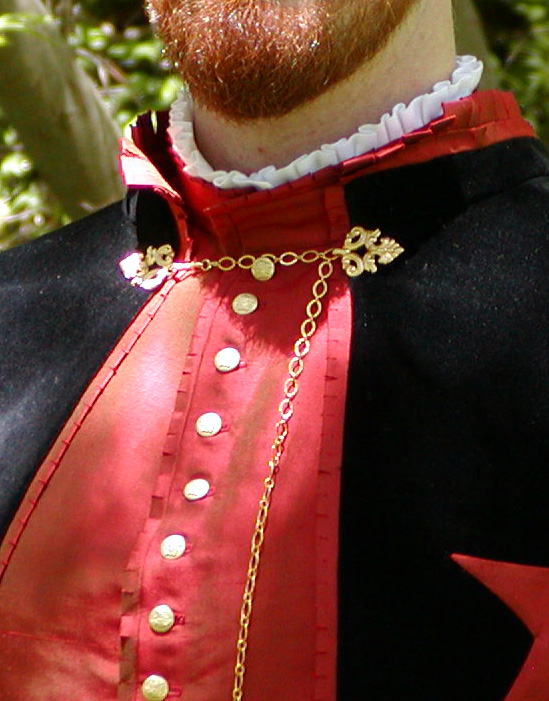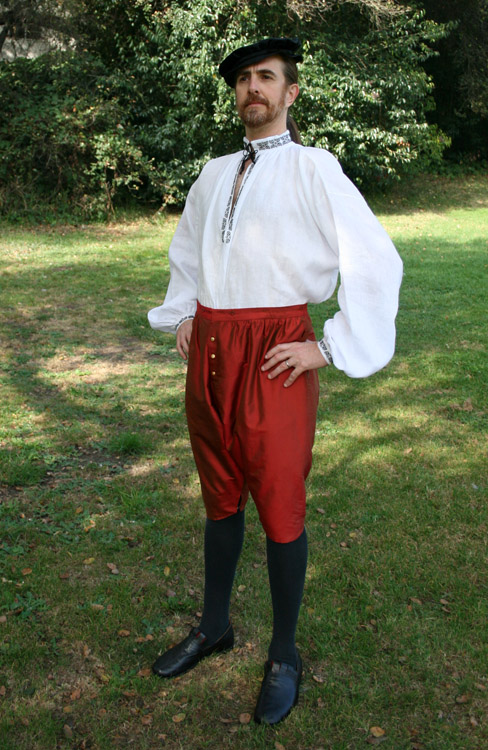
January – June 2007
This changeable silk taffeta was slated for an Italian outfit of one kind or another, and I’d wanted to make Aaron a doublet for quite some time. It seemed logical to make him a costume that would coordinate with one of my own. So, mid-century Italian it was.
I guess this costume could be described as a 1560s Florentine, inspired by a Venetian (the Paolo Veronese below). The basic outfit, like the painting, is a matching suit of doublet, Venetians and cloak. Since the gentleman’s flashy silk cape wasn’t quite right for Aaron, I made it in black velveteen with a red lining. Then I gave it a little twist. The cape is decorated with the symbol for Medici’s Order of Saint Stephen, established in 1560s Florence.
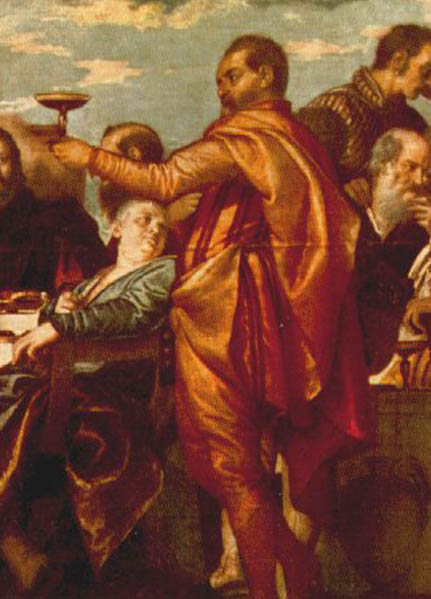
Gemäldegalerie, Dresden
This is, so to speak, a bit of “artistic license.” I have no evidence that this symbol was ever worn decoratively on a cape. It was definitely worn on ceremonial garments – there are fragments of an original on display at the Pitti Palace in Florence. And I was told by a guild member at the Faire that it was also worn on tabards. But this 1542 Titian led me to believe that it was at least plausible. However I honestly can’t tell whether the cross is fixed to his coat, or part of a separate hanging garment. Either way, I like what it adds to Aaron’s costume. I tried to base my version on the facade of this building in Florence. It’s pretty subtle, but I think the 16th C. version Aaron and I saw in the museum was more elongated, and with less space between the spikes – closer to the Titian. But, this is conjecture and I may have misremembered.
2013 edit: I was sent this wonderful image from Paco Smith, of the San Lorenzo Nobles guild at Southern Renaissance Fair. He confirmed that the Cross of Santo Stefano was indeed worn by members on their cloaks.
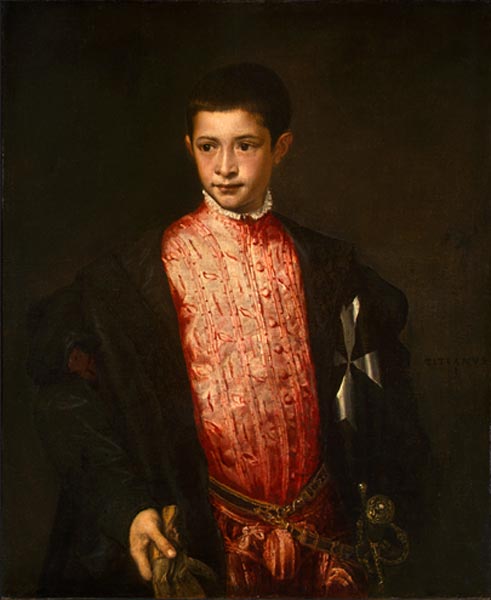
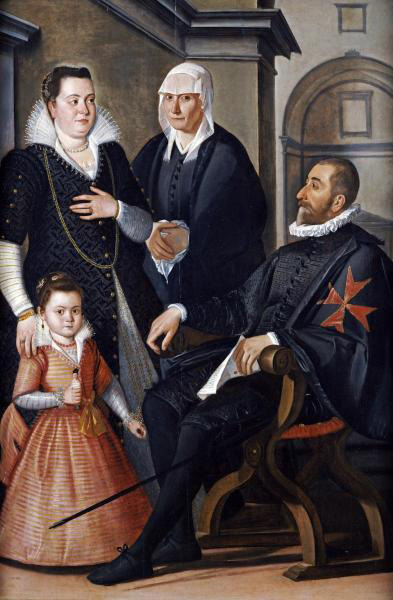


As for the construction, the Venetians were made first. Thanks to The Tudor Tailor’s pattern, they were the easiest part of the whole costume. I decided, on a whim, to add facings to the leg openings. This turned out to be fortunate as we need to unhook Aaron’s pant legs to allow enough ease for him to sit. The fit is nice and snug when he’s standing, just like the inspiration portrait, so I wouldn’t want the legs any wider. It’s easier to unhook the knees, than to loosen all the ties connecting the pants to the doublet (which would also give enough ease). Incidentally, Aaron absolutely loves the pockets. I think it’s his favorite part of the whole costume.
The doublet was based on the 1574 Medici in Patterns of Fashion, and draped on Aaron. (That was really difficult…not only to fit, but on poor Aaron, who got a lot of pins in the ribs.) Then the TTT‘s Henrician sleeves were added. I tried several padding variations, per TTT and POF. Any would have worked fine, had I added them to an early muslin. Instead, I waited too late. So I ended up padding only the back. A peascod belly doesn’t seem necessary for a 1560 Italian, but I would have liked to pad out the chest area. That was where I had the most difficulty, with the whole ‘no-darts’ thing. The doublet is underlined in muslin and interfaced with heavy linen. I found it worked better than duck in this case. There are a couple of stays in the front (cable ties), and it’s lined in hanky weight linen. Metal lacing rings are sewn to the inside of the waist, which match up with corresponding rings on the pants waistband. (I avoid eyelets if at all possible).


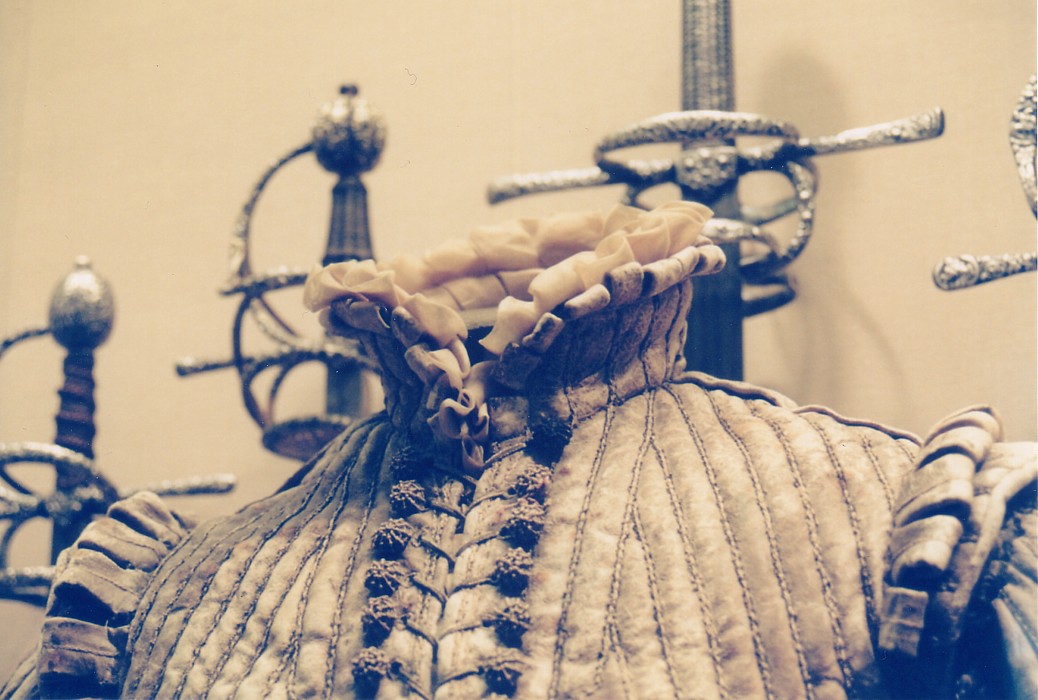
For an added Florentine touch, I copied the trim from the Medici doublet. It’s just little strips of folded bias tape, interfaced with an extremely thin fusible made especially for silk, and then snipped every 3/8″. It’s really subtle. The separate collar and cuffs have their own write-up on the Renaissance linens page. They are basted into the doublet. The concept came from a 16th Century fencing doublet which appears to have sewn-in ruffs. Small metal shank buttons run down the doublet and Venetians, and there are two on each cuff, just like the Medici.
I was looking forward to making a cape. It seemed such an integral part of the the 1560s Florentine man’s costume, as illustrated by their sheer numbers in Moda a Firenze. It’s a 3/4 circle, “pac-man shaped,” as Aaron calls it. The seams were placed so as to imitate period-width fabric. Center front is cut on the straight. I decorated the cape with the same snipped trim as the doublet: around the outer edge, and a double layer at the collar. It can be worn any number of ways: fully closed, partially closed, or under the shoulder.
We seem to pick up rings at every Faire. Aaron was highly bejeweled. The silk hat is also a TTT pattern: the Elizabethan bonnet. One strategically placed button holds his feather in place. Finally, I felt that the only way this costume was going to be complete was with the right footwear. So I ordered some custom shoes with fancy loopy tabs on top.
